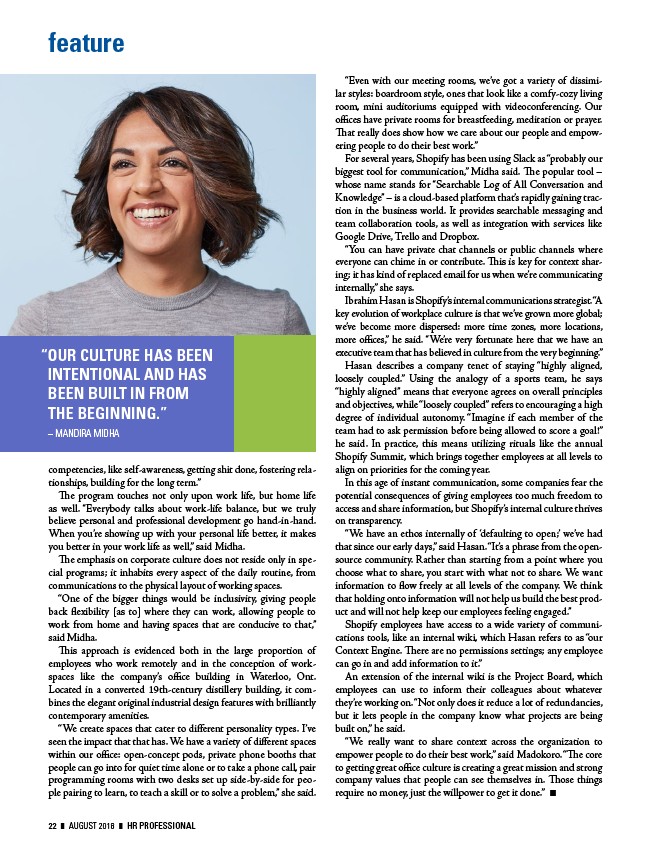
competencies, like self-awareness, getting shit done, fostering rela-tionships,
building for the long term.”
The program touches not only upon work life, but home life
as well. “Everybody talks about work-life balance, but we truly
believe personal and professional development go hand-in-hand.
When you’re showing up with your personal life better, it makes
you better in your work life as well,” said Midha.
The emphasis on corporate culture does not reside only in spe-cial
programs; it inhabits every aspect of the daily routine, from
communications to the physical layout of working spaces.
“One of the bigger things would be inclusivity, giving people
back flexibility as to where they can work, allowing people to
work from home and having spaces that are conducive to that,”
said Midha.
This approach is evidenced both in the large proportion of
employees who work remotely and in the conception of work-spaces
like the company’s office building in Waterloo, Ont.
Located in a converted 19th-century distillery building, it com-bines
the elegant original industrial design features with brilliantly
contemporary amenities.
“We create spaces that cater to different personality types. I’ve
seen the impact that that has. We have a variety of different spaces
within our office: open-concept pods, private phone booths that
people can go into for quiet time alone or to take a phone call, pair
programming rooms with two desks set up side-by-side for peo-ple
pairing to learn, to teach a skill or to solve a problem,” she said.
“Even with our meeting rooms, we’ve got a variety of dissimi-lar
styles: boardroom style, ones that look like a comfy-cozy living
room, mini auditoriums equipped with videoconferencing. Our
offices have private rooms for breastfeeding, meditation or prayer.
That really does show how we care about our people and empow-ering
people to do their best work.”
For several years, Shopify has been using Slack as “probably our
biggest tool for communication,” Midha said. The popular tool –
whose name stands for “Searchable Log of All Conversation and
Knowledge” – is a cloud-based platform that’s rapidly gaining trac-tion
in the business world. It provides searchable messaging and
team collaboration tools, as well as integration with services like
Google Drive, Trello and Dropbox.
“You can have private chat channels or public channels where
everyone can chime in or contribute. This is key for context shar-ing;
it has kind of replaced email for us when we’re communicating
internally,” she says.
Ibrahim Hasan is Shopify’s internal communications strategist. “A
key evolution of workplace culture is that we’ve grown more global;
we’ve become more dispersed: more time zones, more locations,
more offices,” he said. “We’re very fortunate here that we have an
executive team that has believed in culture from the very beginning.”
Hasan describes a company tenet of staying “highly aligned,
loosely coupled.” Using the analogy of a sports team, he says
“highly aligned” means that everyone agrees on overall principles
and objectives, while “loosely coupled” refers to encouraging a high
degree of individual autonomy. “Imagine if each member of the
team had to ask permission before being allowed to score a goal!”
he said. In practice, this means utilizing rituals like the annual
Shopify Summit, which brings together employees at all levels to
align on priorities for the coming year.
In this age of instant communication, some companies fear the
potential consequences of giving employees too much freedom to
access and share information, but Shopify’s internal culture thrives
on transparency.
“We have an ethos internally of ‘defaulting to open;’ we’ve had
that since our early days,” said Hasan. “It’s a phrase from the open-source
community. Rather than starting from a point where you
choose what to share, you start with what not to share. We want
information to flow freely at all levels of the company. We think
that holding onto information will not help us build the best prod-uct
and will not help keep our employees feeling engaged.”
Shopify employees have access to a wide variety of communi-cations
tools, like an internal wiki, which Hasan refers to as “our
Context Engine. There are no permissions settings; any employee
can go in and add information to it.”
An extension of the internal wiki is the Project Board, which
employees can use to inform their colleagues about whatever
they’re working on. “Not only does it reduce a lot of redundancies,
but it lets people in the company know what projects are being
built on,” he said.
“We really want to share context across the organization to
empower people to do their best work,” said Madokoro. “The core
to getting great office culture is creating a great mission and strong
company values that people can see themselves in. Those things
require no money, just the willpower to get it done.” n
feature
“OUR CULTURE HAS BEEN
INTENTIONAL AND HAS
BEEN BUILT IN FROM
THE BEGINNING.”
– MANDIRA MIDHA
22 ❚ AUGUST 2018 ❚ HR PROFESSIONAL